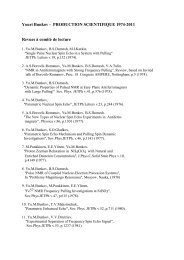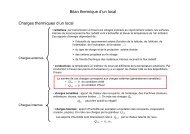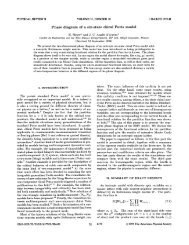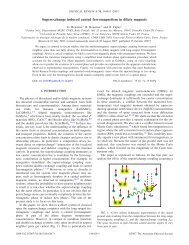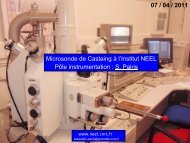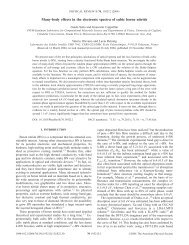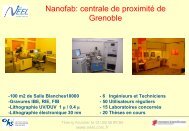Activity Report 2010 - CNRS
Activity Report 2010 - CNRS
Activity Report 2010 - CNRS
Create successful ePaper yourself
Turn your PDF publications into a flip-book with our unique Google optimized e-Paper software.
SCIENTIFIC REPORT<br />
Magnetic Microsystems<br />
“Fil de l’eau” PhD student 2007: Mikhail<br />
KUSTOV<br />
Coordinators: Nora DEMPSEY (Institut<br />
Néel), Orphée CUGAT et Gilbert REYNE<br />
(G2ELab)<br />
Due to the scalability of magnetic forces<br />
upon reducing size, they are successfully<br />
used in microsystems. A close<br />
collaboration covering materials sciences<br />
and electrical engineering, and potential<br />
users (such as biologists) allowed us to<br />
optimize arrays of micro-patterned hard<br />
magnets (NdFeB). The stray fields<br />
produced are fully characterized thanks<br />
to the development of new tools such as<br />
3D measurements using a singlecomponent<br />
Hall probe and quantitative<br />
magneto-optic imaging using a uniaxial<br />
magneto-optic indicator film in a bias<br />
field [9]. New micro-systems have been<br />
demonstrated, such as the "flying carpet"<br />
shown in Fig.5, or micromagnet arrays<br />
for the manipulation of biological objects.<br />
QUANTUM<br />
SPINTRONICS<br />
Downscaling spintronics devices one<br />
reaches the limit of single magnetic<br />
molecules and atomic spins in magnetic<br />
quantum dots. A major challenge here is<br />
to read and manipulate the spin states<br />
and to perform basic quantum<br />
operations. On the one hand, Carbon<br />
nanotubes (CNTs) are very good<br />
candidates to study these effects due to<br />
their high sensitivity to small changes in<br />
the electrostatic environment. On the<br />
other hand, inserting a single Mn atom<br />
into a quantum dot provides the ultimate<br />
tool to manipulate individual spin states.<br />
Finally, for developing beyond “CMOS”<br />
nanoelectronics, graphene as a new<br />
material has emerged recently. The<br />
conditions under which the magnetic<br />
order can be obtained is explored<br />
theoretically by atomic scale<br />
‘nanopatterning’.<br />
Magnetic order in graphene<br />
Chair of Excellence 2007: Mairbek<br />
CHSHIEV<br />
PhD student: Hongxin YANG<br />
(INAC/SPINTEC).<br />
FURTHER READING:<br />
[9] J. Appl. Phys. 108, 063914 (<strong>2010</strong>)<br />
Magnetic characterization of<br />
micropatterned Nd-Fe-B hard magnetic films<br />
using scanning Hall probe microscopy<br />
10<br />
Fig. 5: The "flying carpet": the design of the<br />
assembly of micromagnets ensures stability in<br />
both directions and can replace complex<br />
systems involving superconductors and<br />
associated cryogenics.<br />
Spin transfer torque in<br />
nanoparticles<br />
“Fil de l’eau” PhD student 2008: Irina<br />
GROZA<br />
Coordinator: Alain MARTY (INAC/SP2M).<br />
Aggregates of magnetic Co/CoO coreshell<br />
nanoparticles (5 nm diameter)<br />
provide a test system to study the effect<br />
of the spin polarized current on the<br />
antiferromagnetic exchange bias from the<br />
CoO to the Co. As a first step a few tens<br />
of nm thick films of nanoparticles were<br />
prepared and the correlation between the<br />
particles was established using the<br />
magneto-resistance effect. At room<br />
temperature, the CoO is unblocked and<br />
the correlation comes from the dipolar<br />
interaction between particles.<br />
Huge values of the charge mobility in<br />
addition to a weak intrinsic spin-orbit<br />
coupling in carbon-based sp 2 structures<br />
could potentially allow for very large<br />
(micron long) spin diffusion lengths.<br />
These features, together with the other<br />
”semi-conductor like” properties of<br />
graphene, make graphene-based<br />
spintronic devices highly promising and<br />
have triggered a quest for controlling<br />
spin injection in graphene. Many routes<br />
have been attempted to induce<br />
magnetism by proximity effect or inject<br />
spins from magnetic electrodes. Here we<br />
graphene nanomeshes investigate by<br />
first-principles calculations to address the<br />
important question of whether and under<br />
what conditions graphene can exhibit<br />
correlated (ordered) magnetic properties.<br />
By removing an equal number of A and B<br />
sites of the graphene bipartite lattice, a<br />
regular network of atomic scale vacancies<br />
is obtained. Such a nanomesh (Fig. 6)<br />
made mostly of zigzag (armchair) type<br />
edges exhibits antiferromagnetic (spin<br />
unpolarized) states. In contrast, in a<br />
situation of sublattice symmetry<br />
breaking, stable ferrimagnetic states are<br />
obtained. For a hydrogen-passivated<br />
nanomesh, the ground state is found to<br />
strongly depend on the vacancies shape<br />
and size. The obtained net magnetic<br />
moments increase with the difference<br />
between the number of removed A and B



